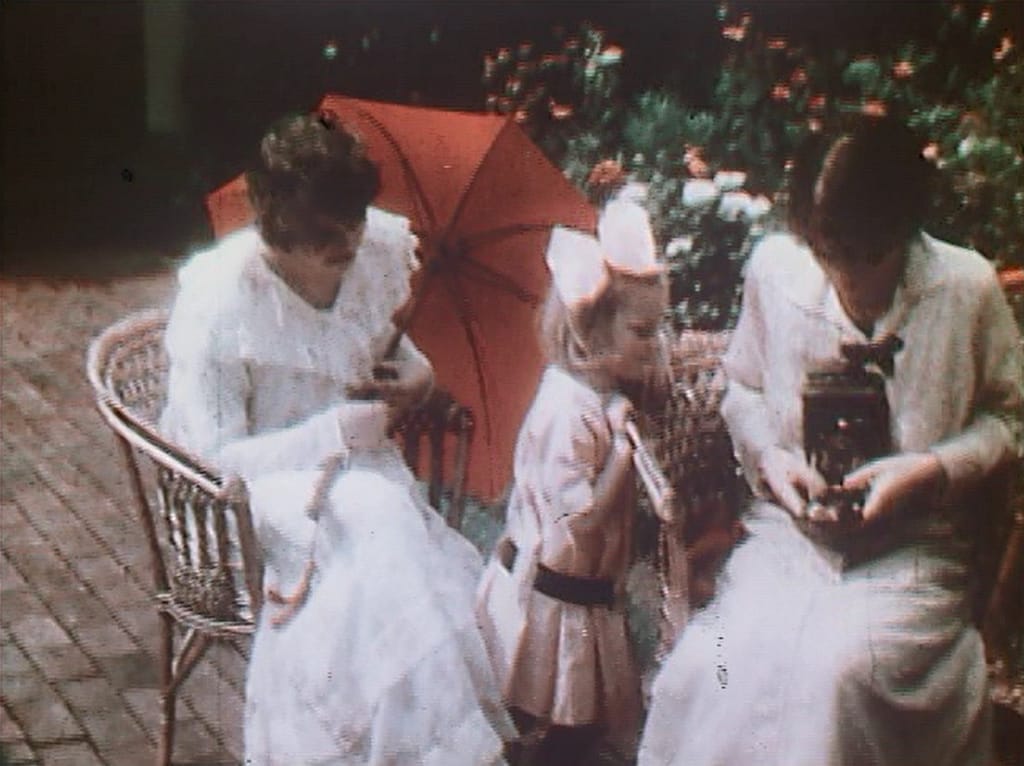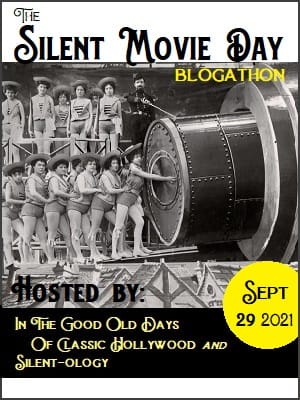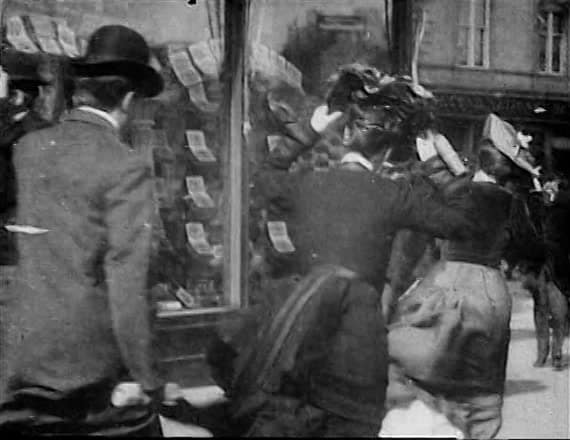
Outside of a few big names like George Melies or D.W. Griffith, whenever silent movies are mentioned there is a good chance that people are talking about the 1920s. From Dr. Caligari to Safety Last and Phantom of the Opera to The Passion of Joan of Arc, the most well-known silent movies are from the 1920s made in the Hollywood studio system or amongst a handful of European national cinemas. While the 1920s is one of the most vibrant and expressive decades of film history, our focus on 1920s silent film overshadows the many triumphs of the first twenty-five years of projected cinema.
Even during the silent era, pre-1920 cinema was routinely underappreciated, undervalued, and even ridiculed. As film became an international entertainment industry in the first decade of the 20th century, early films were routinely dismissed as cheap, lower-class entertainment. For instance, several 1920s theater exhibitors offered a program called The Old Time Movie Show that screened films from the 1900s and 1910s that invited audience members to laugh at the films’ acting and ‘primitive’ filmmaking. Even the survival rate of silent films made before 1920 is significantly lower than silent films released after 1920!
On the first-ever National Silent Movie Day, I’m shining a light on the all too often neglected, wonderful world of Pre-1920 cinema. Featuring actualities documenting late 19th-century life, frantic chase comedies from the Nickelodeon era, and the ambitious early feature films, Pre-1920 cinema boasts a wide variety of genres and filmmaking styles that will pique many classic film fans’ unique interests. To celebrate pre-1920s cinema, I share what I love about each distinct era of pre-1920 cinema and recommend some of my personal favorite films of the era that you can watch today to celebrate 2021’s National Silent Movie Day.
This post is part of Silentology‘s and In The Good Old Days of Classic Hollywood‘s Silent Movie Day blogathon celebrating the first-ever National Silent Movie Day. Visit the blogathon’s main page to read other great posts celebrating silent cinema.
Early Cinema (late 1880s-1905)
It took decades for inventors, electricians, and entertainers to develop the necessary technology to create moving pictures. Building upon the success of 19th-century photography and magic lantern shows several inventors around the world in 1895 successfully projected films to audiences. At first, film was such a novelty that movies about such mundane subjects as a busy city street or a baby eating lunch were enough to excite 1890s audiences. As the novelty wore off and films increased in popularity, filmmakers began to experiment with new ways to tell stories and excite an audience eager to see what the new medium could do.
For modern audiences, early cinema remains surprisingly accessible. The films’ short runtimes (typically ranging from mere seconds in the late 1880s to around ten minutes by 1905) allow you to expose yourself to so much in such a short time. The films of the Lumiere brothers, R.W. Paul, Alice Guy-Blache, and George Melies still entertain and engage modern audiences even as they experimented with various storytelling and editing styles that we take for granted today. Early cinema also covers a wide variety of topics and subjects with something interesting to offer to everybody. Films of the era captured popular Vaudeville acts, reenacted historical and current events, filmed famous tourist attractions around the world, observed everyday Victorian urban life, and created elaborate fairy tales and visions unique to the world of film.
I personally love the many actualities that document the Gilded Age, capturing both everyday life and customs that have longed since changed and major world events of the time. Whether a short snapshot of New Yorkers holding onto their hats on a windy day, the coronation of a European monarch, or the first recorded footage of the pyramids at Giza, these early films provide a unique window to a forgotten world that has changed so much over the past century-plus. Early cinema’s record of historical and cultural events showed the potential of the young medium just as much as the fantastical worlds of George Melies and remain as unique historical records of the era.
New Yorkers hold onto their hats on a windy day in At the Foot of the Flatiron (1903).
Recommendations:
Roundhay Garden Scene (1888) – The oldest surviving moving picture that only lasts about three seconds. Photographed by Louis Le Prince, the film captures three people walking in Prince’s backyard and the trees blowing in the background. His grandmother photographed in the film would die only ten days after shooting the film.
Demolition of a Wall (1896) – Right from the beginning filmmakers learned to play around with film, creating images that could not have been put together any other way. This film of a wall’s demolition plays the footage in reverse, a surreal and intriguing twist.
Something Good, Negro Kiss (1898) – The majority of African American representations in American classic film are unflattering, to say the least. (Just look at the titles of some early Edison films). This film however showcases a cute kiss between two African American performers that stands in stark contrast to the various racist stereotypes too often parroted in early film.
The Big Swallow (1901) – The British were some of the most inventive filmmakers right from the start. Williamson’s film uses camera trickery to show a man swallowing the cameraman!
Jack and the Beanstalk (1902) – Melies’ fantastical films like A Trip to the Moon and Kingdom of the Fairies were such big successes around the world that several other filmmakers imitated his style. Edwin S. Porter’s adaptation of Jack and the Beanstalk is a great example of an American film inspired by Melies’ pioneering work, using highly decorated backgrounds to transport viewers to a fantastical world that could only be created on film.
At the Foot of the Flatiron (1903) – Shot on the city streets of New York, this film captures a short snapshot of New Yorkers going about their day holding onto their hats on a windy day. Humorous despite its documentary style, the film transports us back to a time when the hat was an everyday fashion item and a major liability on a windy day.
The Night Before Christmas (1905) – Many early narrative films relied on well-established stories to appeal to audiences oftentimes including text straight from stories as title cards. Porter’s short adaptation of the beloved Christmas poem includes Santa’s workshop, his reindeer, and a raucous Christmas Eve pillow fight among children waiting for Santa.
The Nickelodeon Era (1906-1914)
While most early films had been shown at roadshows and by traveling exhibitionists, storefront theaters built after 1905 dedicated solely to exhibiting weekly or daily programs of film increasingly became the most common venue for audiences to experience the cinema. Nicknamed the Nickelodeon because of their five-cent entry fee, these theaters announced that films were no longer a fleeting novelty but a budding entertainment that was here to stay. Demanding more and more films to fill their screens and rotating their film programs twice weekly if not daily, Nickelodeons incentivized the creation of more studios and more films.
During this explosion in film production and exhibition, filmmakers become more and more ambitious. Innovative filmmakers increasingly experimented with different camera setups and various editing techniques to create a cinematic language efficient in conveying information to audiences. Films slowly grew longer and longer as dramas routinely stretched out over twenty minutes. Filmmakers adapted Shakespeare plays and Dickens novels, solidified the genre conventions of slapstick comedy and the western, and created the first movie serials. While actualities capturing never-before-photographed locations and everyday life dominated early cinema, the films of the Nickelodeon Era increasingly committed themselves to create fictional narratives for their audiences.
I love the experimental nature of the Nickelodeon Era which saw a proliferation of animation styles, new genres, and innovative ways to sell films to audiences that we still use today. For the first time, actors like Max Linder, Florence Lawrence, and Mary Pickford were promoted by name, drew people to the theaters, and graced the cover of the first fan magazines. Films in the Nickelodeon Era increasingly shot actors in close-ups, cross-cut between different locales and storylines, relied on title cards to explain scenes shown onscreen, and began to move the camera using panning and tracking shots. If early cinema was the beginning of motion pictures, the Nickelodeon Era is the adolescent years of the artform that built upon the achievements of early filmmakers to create new worlds, genres, and storytelling devices unique to motion pictures.
Police snatch up criminals off the streets and hold them in their blimp in The Police in the Year 2000 (1910).
Recommendations:
The Consequences of Feminism (1906) – Pioneering director Alice Guy-Blache dares to ask the question, what would society look like if men’s and women’s roles were reversed? In a comic way, Guy-Blache’s film shows that early filmmakers were more than willing to tackle the complicated social issues of their day.
The Dancing Pig (1907) – Every era of film will have an oddity or two. The Dancing Pig is my pick for one of the weirdest films of the Nickelodeon Era, featuring an actor in a pig suit, with movable eyes, ears, and a mouth, flirting and dancing with women.
Modern Sculptors (1908) – Segundo de Chomón was one of Pathe Ferres’ most innovative directors often playing with hand-drawn color and special effects in his films. In Modern Sculptors, through clever cuts and stop-motion photography, various sculptures come to life and move on their own.
Fantasmagorie (1908) – No genre of film was as experimental as animation. Emile Cohl’s hand-drawn animated film is crude, relying on drawings of stick figures without backgrounds, but captures motion much more realistically than the stop motion animation previously used in the Nickelodeon Era.
The Police in the Year 2000 (1910) – This Gaumont sci-fi comedy follows a squad of police officers flying in a blimp and using long sticks to snatch criminals off the street to place them in their temporary holding cell in the sky. While the film is more concerned about drawing laughs from the audiences than predicting the future, it is interesting to see what technologies fascinated audiences of the day and how films depicted the future long before big-budget science fiction films.
The Cameraman’s Revenge (1912) – Polish-Russian director Wladyslaw Starewicz boasts one of the most unique filmmaking techniques in the silent era. In many of his stop-motion films, he used dead, dried insects as his main characters. The Cameraman’s Revenge features a grasshopper cameraman who exposes a beetle’s affair by filming him and his mistress and screening it for all the town to see.
The Bargain (1914) – The myth of the American West loomed large in American culture as many Americans during the time had lived through the last decades of American western expansion. After Hollywood established itself as a strong competitor to New York film production, dozens of feature-length westerns utilized authentic Western landscapes. William S. Hart’s first film role solidified his good-bad man image as his Western robber character attempts to go straight after attending to some unfinished business.
The Feature Film (1915-1919)
After the success of several international feature-length spectacles in the early 1910s, the hour-long plus feature film became the industry’s mainstay by the mid-1910s. Bigger budgets, bigger stars, and the ever-increasing persona of directors elevated cinema to an art form and an accepted entertainment for people of all backgrounds. By the end of the decade, Hollywood filmmaking became the world’s largest producer of films and established the star system as the backbone of the industry’s advertising model. Innovators like Thomas H. Ince streamlined a more efficient motion picture production process by creating production units and specifying the roles of directors and producers. Films of the period doubled as both the profitable commodity of a burgeoning global industry and an evening’s entertainment for the public.
The feature films from the 1910s are often not as polished as their 1920s counterparts but make up for it in their independence. While major studios consolidated their power in the 1920s and dictated what could and should be done in their films, the 1910s offered more freedom for top directors to craft their own films to their own liking. Women were given numerous opportunities in the late and mid-1910s to produce, write, and direct popular films in an industry that afterward would largely become an all-boys club.
I love the socially conscious films of the era that squarely address controversial topics. While many classic film studios later would aim to keep their films clean of politics, controversial social causes, and accurate depictions of sex and poverty, the more independently minded 1910s films advertised nudity and tackled such controversial issues as abortion, capital punishment, poverty, immigration, and sex trafficking. Films like Regeneration (1915) and The Italian (1915) give sympathetic but frank depictions of slums, poverty-riddled tenements, and poor immigrant communities. Films like Where Are My Children? (1916) and Margaret Sanger’s now lost Birth Control (1917) openly discussed birth control and abortion.
Even in the midst of such seriously minded films, the 1910s also boasts some of the best examples of short one and two-reel comedies. Chaplin became a worldwide superstar, Lloyd perfected his boy-with-glasses character, and Max Linder was at the height of his creative genius at the time. Both slapstick comedies and more character comedies became a mainstay on film programs, inducing audience laughter shortly before the screening of feature films placed at the end of the theater’s program. With their classic comedy, ambitious dramas, and newly formed film grammar, the films of the late 1910s wait to be rediscovered and enjoyed by classic film fans everywhere.
Color, as shown in Concerning $1,000 (1916), was just one of the many technological advances filmmakers in the 1910s experimented with.
Recommendations
Hypocrites (1915) – Lois Weber stands as one of, if not the, most talented filmmakers of her era. Hypocrites, an expose of religious hypocrisy in the Progressive Era, is the film that elevated her into the discussion, alongside D.W. Griffith and Cecil B. DeMille, as the greatest director working in Hollywood.
The Battle of the Somme (1916) – Even as fiction narrative films had become the dominant form of cinematic storytelling, feature-length film documentaries still enticed audiences and left behind fascinating visuals of important historical events. The Battle of the Somme features of footage of British soldiers on the front lines as they prepare artillery machines for combat, tend to the wounded, and engage in trench warfare. Just like the actualities of early cinema, this documentary brings history to life and provides modern viewers with a unique view of soldiers on the frontlines of World War I.
Concerning $1,000 (1916) – Running a little over a minute, this film is one of the earliest color films with a fictional narrative. Produced by the Kodak Eastman company, the film showcases the potential for color-on-film processes that would dominate the industry decades later.
A Movie Star (1916) – Keystone, best known for its frantic chases and the bumbling Keystone cops, also produced some more character-driven, story-driven comedies. A Movie Star cracks fun at actors’ star personas and gives comedy stalwart Mack Swain time to shine on his own.
Stella Maris (1918) – The biggest star of the time, Mary Pickford plays a dual role in the film as a sheltered, rich woman and an orphan. Pickford’s two roles showcase both her appeal to audiences as the girl with the golden curls and her ability as an actor to lose herself in a role.
Ask Father (1919) – While feature films came to dominate the market by the mid-1910s, comedy largely stayed in the short film format. Harold Lloyd’s one-reeler Ask Father, centered around Harold’s frivolous attempts to barge into his suitor’s father’s office to ask for his daughter’s hand in marriage, showcases the hilarity many comics of the era could pack into ten minutes.
When the Clouds Roll By (1919) – Douglas Fairbanks in the 1920s would cement his legendary status in the film pantheon of actors as a swashbuckling adventurer in his numerous costume dramas. In the 1910s, however, Fairbanks mainly worked in modern comedies that showcased his athletic abilities. A zany comedy that plays to Fairbanks’ strengths as a performer, When the Clouds Roll By includes a mad scientist and a hallucination where Fairbanks is being chased by various vegetables.








This is a great look at a neglected era, even among silent movie buffs. I agree there is great interest in these earlier films, especially the feature films of the 1910s. Like you said, this was before the studio system took control, so we got a lot of interesting social problem movies that would have inevitably been glossed up just a few years later. That relative grittiness is part of why the 1910s is such a fascinating decade for the movies.
Thank you for this overview, and for curating these lists of films. Your essay is going to be a very handy reference for me.
P.S. I gasped when I saw the colour image you posted. It’s so beautiful and vivid.